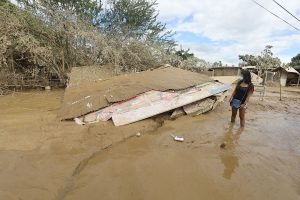PRESIDENT Ferdinand R. Marcos, Jr. said he aims to pitch investors by calling their attention to the underlying strength of the Philippine economy, saying that stripping out climate impacts and other elements beyond the country’s control provide a clearer picture.
“When you look at our financial numbers, you have to isolate the shocks that are hitting the economy and remove agriculture to be able to understand clearly what is happening, which are shocks that are completely out of control,” he said at a World Economic Forum briefing on Tuesday at the Palace, based on a transcript distributed to reporters.
“So, the shift from fossil fuels to renewable is something that takes up a great deal of our thinking and that is why many of the investments that we are hoping to attract are in that area, in renewables,” he added.
He said the Philippines is looking to attract more government-to-government investment to support the green transition and to help digitalize the bureaucracy.
The official target for the share of renewable energy (RE) in the power generation mix is 35% by 2030 and 50% by 2040. RE currently accounts for 22% of the mix.
Based on a study by economists at the Bangko Sentral ng Pilipinas published last week, rising temperatures and climate shocks such as the El Niño weather phenomenon could fan inflationary pressures and reduce economic output over the next few years.
Central bank experts projected that the inflationary effect of these climate shocks was “significantly” persistent up to the fourth year after a shock.
Temperature shocks could increase headline inflation by 0.46 percentage point (ppt) in the short term and as much as 0.81 ppt long term, they said.
Inflation accelerated for the first time in five months to 3.4% in February as food prices continued to rise. Rice inflation surged to 23.7% that month.
At the same forum, San Miguel Corp. President and Chief Executive Officer Ramon S. Ang contested the idea of the Philippines not being competitive due to its high power and fuel costs, arguing that such costs appear high since other Asian countries’ energy sectors are subsidized.
“The Philippines, comparing its actual power and fuel cost with other countries, (would be) the lowest in Asia (without) the Philippine government’s imposition of excise tax and value-added. All other countries subsidize their fuel and power,” he said.
Meanwhile, Mr. Marcos said the government is also focused on attracting more investment in digital upskilling and new forms of technology for the energy sector.
“Whenever we speak of investments, I always ask (whether) we have, in fact, a training program (and), if there is a transfer of technology,” he said.
“For workers, to be able to compete properly in the international markets, specialized skills are necessary,” he added.
Last week, US Secretary of Commerce Gina Raimondo said US companies pledged to bring in more than $1 billion in investments to the Philippines.
She said about 30 million workers are expected to benefit from the US digital upskilling investment pledges.
Secretary of State Antony Blinken, who visited Manila this week, said the US will continue supporting Philippine manufacturing and the clean energy sector. — John Victor D. Ordoñez
